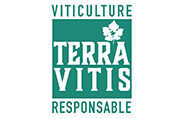

Château Ferrande’s vines cover an area of 97.5 hectares, 90 of which are planted with red varieties, with Merlot and Cabernet Sauvignon represented equally. The plots dedicated to white varieties are, for their part, made up of 40% Sémillon and 60% Sauvignon, with an above average proportion of Sauvignon Gris. This specificity sets the vineyard apart, as does a heavy plantation density that makes for optimal ripeness (9600 vines/hectare).
The unique expression of the varieties planted on Château Ferrande’s vineyards is, first and foremost, a result of the property’s exceptional terroir. The soil is composed of Guntzian gravel, large pebbles usually found at First Growth properties, which here are cherished like precious stones. Château Ferrande’s gravel is supported by clay-rich subsoil, providing the perfect foundation for wines that combine maturity and freshness, force and finesse…



Although forged of stone, Château Ferrande’s terroir is nevertheless fragile. The geological lacework that brought it into existence requires the utmost care and attention. This is why, in spite of the vineyard’s size, chemical herbicides have long been abandoned in favour of grass covers and mechanical tillage. This mobilisation in favour of responsible vineyard management is only possible thanks to the unwavering support of the property’s dedicated team.
This long-standing commitment was confirmed when the property obtained the Terra Vitis certification in 2019, which remains the subject of considerable investment. At the same time, more than a kilometre of hedges were planted around the property, encouraging the development of biodiversity.


The Château Ferrande terroir is a legacy that must be protected, and every harvest is a bequest that commands respect. With this in mind, the Château Ferrande winery underwent a comprehensive renovation in 2005. Just as in the vineyard the soil is set apart by its capacity for temperature control, the winery’s stainless steel, thermoregulated vats allow for the utmost precision. A distinguished vineyard demands a distinctive approach to winemaking.
At Château Ferrande, precision relates as much to innovation as to tradition. As such, during the construction of the new winery, the property doubled the capacity of its barrel cellar. French oak barrels, toasted lightly but for a significant amount of time, are sourced from a number of different cooperages in order to find the perfect balance of density, boldness, and sweetness. The red wine is aged for twelve to fourteen months, and the white for eight. Both undergo bâtonnage to extract further aroma, flavour and texture. Requiring great precision, the time-honoured act of stirring the lees enables the winemaker to reveal the potential of Château Ferrande’s precious terroir.


We are but temporary custodians of Château Ferrande’s architectural, natural and viticultural heritage. While destined to be passed on through the generations, its legacy must also be shared today. An integral part of this mission is the duty to preserve the château’s heritage, as well as its reputation for distinctive, distinguished wines.